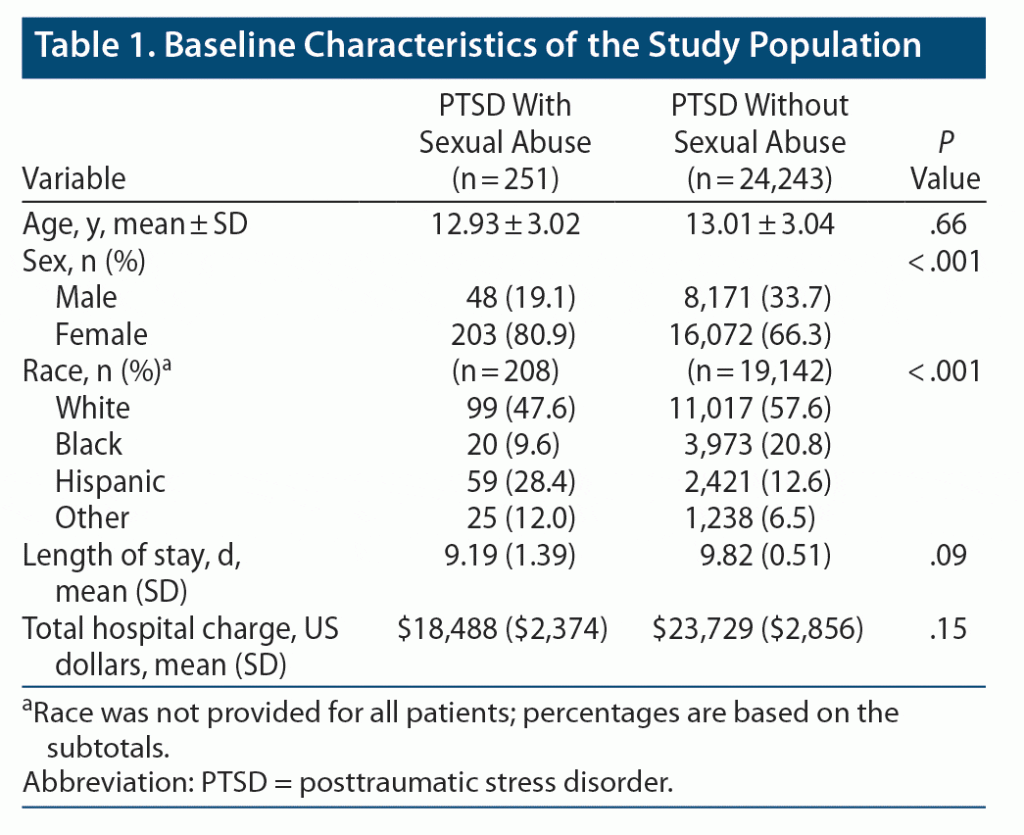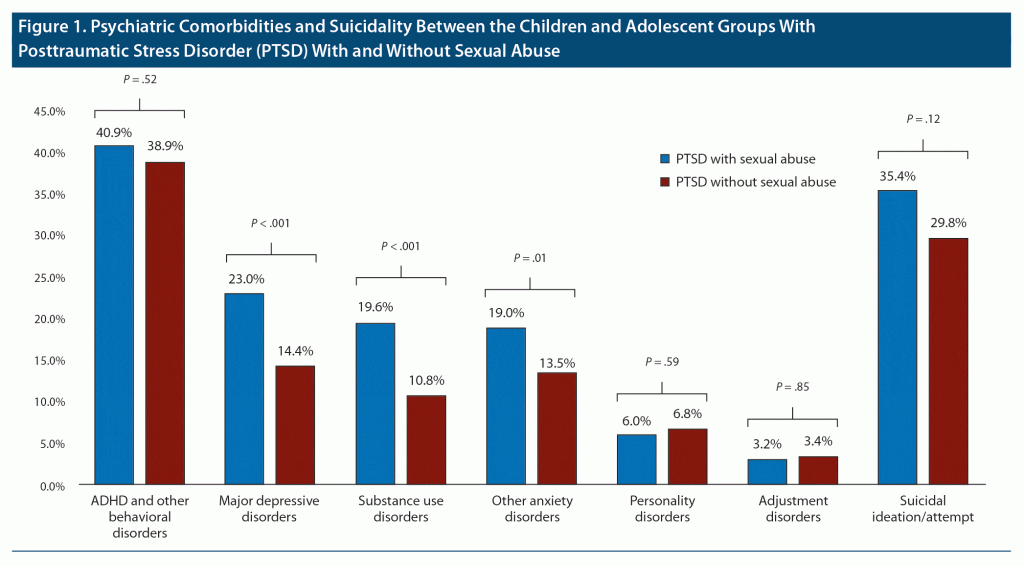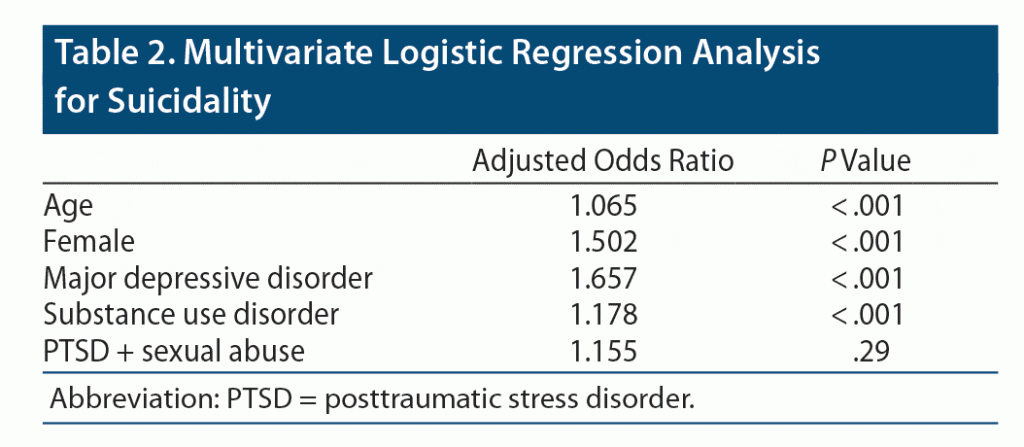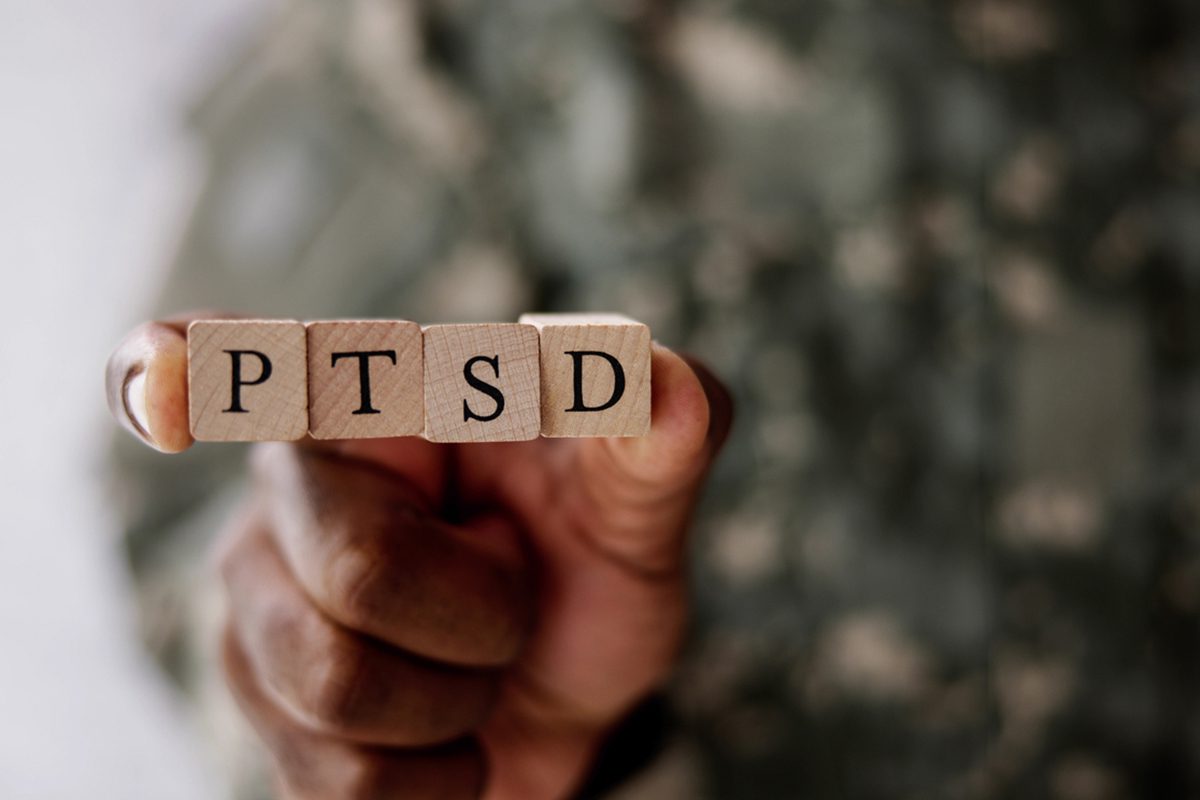ABSTRACT
Objective: Sexual abuse in minors aged 6–17 years is a significant public health concern. Victims of sexual abuse are at risk of developing complex psychopathology and chronic suicidal thoughts. Posttraumatic stress disorder (PTSD) develops in one-third of minors with a history of sexual abuse. The primary objective of this study was to assess the baseline characteristics of minors with PTSD and a history of sexual abuse (PTSD+S) compared with minors with PTSD without sexual abuse (PTSD only). The secondary objective was to evaluate the psychiatric comorbidities and suicidal ideation/attempts between the groups.
Methods: The National Inpatient Sample database from 2006 to 2014 was analyzed using the ICD-9 code for PTSD and history of sexual abuse. PTSD+S (n = 251) subjects were compared with those with PTSD only (n = 24,243) using t test and χ2 test. Univariate and multivariate logistic regression analyses were performed with suicidal behavior (suicidal ideation/attempt) as the outcome and PTSD with and without sexual abuse, sex, age, and other psychiatric comorbid conditions as independent variables.
Results: More patients in the PTSD+S group were nonwhite (52% vs 42%, P < .001) and female (81% vs 66%, P < .001) compared to PTSD only patients. Also, more patients were Hispanic in the PTSD+S group compared to the PTSD only group (28% vs 13%). Major depressive disorder (MDD; 23% vs 14%, P < .001) and substance use disorder (SUD; 20% vs 11%) were more commonly diagnosed psychiatric comorbidities in the PTSD+S group (P < .001). Suicidal behavior (suicidal ideation/attempt) was higher in the PTSD+S group than in PTSD only patients (36% vs 30%, P = .05). Overall, the risk of suicidal behavior was 29% higher in the PTSD+S group than in PTSD only patients (odds ratio [OR] = 1.29, P = .05). In the multivariate analysis, after controlling for age and sex, comorbid diagnosis of MDD (OR = 1.66, P < .001) and SUD (OR = 1.18, P < .001) was associated with increased suicidal behavior. However, PTSD+S showed no association with suicidality (OR = 1.16, P = .29) in the multivariate analysis.
Conclusions: Sexual abuse is associated with PTSD and higher risk of comorbid psychiatric illnesses, including MDD, SUD, and suicidal behavior. In-depth research on the relationship between child and adolescent sexual abuse and chronic suicidality is warranted.
Prim Care Companion CNS Disord 2023;25(1):22m03239
To cite: Mainali P, Motiwala F, Trivedi C, et al. Sexual abuse and its impact on suicidal ideation and attempts and psychiatric illness in children and adolescents with posttraumatic stress disorder. Prim Care Companion CNS Disord. 2023;25(1):22m03239.
To share: https://doi.org/10.4088/PCC.22m03239
© 2023 Physicians Postgraduate Press, Inc.
aDepartment of Psychiatry, Case Western Reserve University/Metro Health Medical Center, Cleveland, Ohio
bDepartment of Psychiatry, Boston Children’s Hospital/ Harvard Medical School, Boston, Massachusetts
cDepartment of Psychiatry, Texas Tech University Health Science Center at Odessa/Permian Basin, Odessa, Texas
dDepartment of Psychiatry, The University of Texas Rio Grande Valley, Harlingen, Texas
‡Drs Mainali and Motiwala share equal contribution for first authorship. Drs Jain and Mansuri share equal contribution for senior authorship.
*Corresponding author: Pranita Mainali, MD, Department of Psychiatry, Case Western Reserve University/Metro Health Medical Center, 2500 Metro Health Dr, Cleveland, Ohio 44109 ([email protected]).
Child sexual abuse is any sexual behavior or contact by an adult or significantly older individual with or upon a child for the purposes of sexual gratification or financial benefit of the offender.1 According to a survey in 2016 from the US Department of Health and Human Services, Administration for Children and Families, 57,329 children had been sexually abused.2 One in every 9 girls and 1 in every 53 boys under the age of 18 years is sexually abused or assaulted by an adult.3 Females account for 82% of all victims under the age of 18 years.3 Victims of rape, attempted rape, or sexual assault are 4 times more likely to be girls aged 16–19 years compared to the overall population.3–5 In the United States, there is a greater annual economic impact of child sexual abuse. The total economic burden in 2015 was estimated to be $9.3 billion, which includes costs associated with health care, child welfare, special education, violence and crime, suicide, and survivor productivity losses.6 Childhood sexual abuse is also noted to have a worse impact on the victim’s family. A study7 found that mothers of sexually abused children reported higher levels of overall emotional distress, poorer family functioning, and lower parental role satisfaction compared to mothers of non-abused children. Fathers of sexually abused children experienced more overall emotional distress than fathers of non-abused children, but their level of distress remained lower than that of mothers.7 Child sexual abuse can have long-term consequences for the victim’s mental health. Victims are more likely than nonvictims to experience mental health issues such as substance abuse, posttraumatic stress disorder (PTSD), and depression.8
The National Comorbidity Survey analysis showed a correlation between child sexual abuse and the subsequent onset of psychiatric disorders, with findings revealing that 78% of females and 82% of males who reported child sexual abuse met diagnostic criteria for at least 1 lifetime psychiatric disorder compared to individuals who did not report child sexual abuse (49% and 51%, respectively).9,10 Depression, suicide attempts, low self-esteem, anxiety and nightmares, somatic complaints, withdrawal, attention and concentration problems, and eating disorders have all been shown to be associated with sexual abuse.10–18 One of the most common constellations of symptoms reported by victims of sexual assault appears to be PTSD, and research found that 57% of teenagers who have experienced a sexual trauma had PTSD.16,17,19 Intrusive symptoms, avoidance of trauma-related stimuli, and hyperarousal are all indicators of PTSD.19,20 Prior victimization was found to increase the level of posttraumatic stress symptomatology in children who had experienced child sexual abuse, suggesting that prior victimization is a factor that mental health professionals who counsel child victims of sexual abuse should consider.20,21 Childhood sexual abuse is recognized as a form of trauma that has substantial, long-term psychological consequences in later life, including sexual dysfunction, sadness, anxiety, fear, aggression, and suicidal ideation.21–23 Studies1,22,23 have shown that suicidal ideation is directly associated with childhood sexual abuse. Suicide is a serious issue in childhood and early adolescence, but it becomes more common as people get older. Suicide rates per 100,000 individuals were 0.5 for females and 0.9 for males aged 5–14 years and 12.0 for females and 14.2 for males aged 15–24 years.22
The primary objective of this study was to assess the baseline characteristics of minor PTSD patients (aged 6–17 years) with a history of sexual abuse (PTSD+S) and compare with those of minor PTSD patients without a history of sexual abuse (PTSD only). We also evaluated the difference between the prevalence of comorbid psychiatric conditions and suicidality between the 2 groups.
METHODS
We included children and adolescents aged 6–17 years from the National Inpatient Sample (NIS) database (from 2006–2014) with a primary diagnosis of PTSD.23,24 The dataset is an annual record of an almost 20% stratified sample of all US community hospital discharges. We obtained national estimates by providing discharge-level weights (trendwt/discwt). The dataset has information on age, sex, race, hospital characteristics, length of stay, total charge, hospital characteristics, and discharge disposition. The dataset also provides the ICD-9 code for the primary diagnosis (an indication of admission) and secondary diagnosis information.
We obtained our sample population with a primary diagnosis of PTSD using ICD-9 code 30981 and categorized the patients based on history of sexual abuse (ICD-9 code 99553). Our final cohort was composed of 2 groups: PTSD+S and PTSD only. We obtained data on the prevalence of substance use disorder (SUD), major depressive disorder (MDD), suicidal behavior, personality disorder, other anxiety disorders, adjustment disorders, schizophrenia, and other psychotic disorders. We collected data on the severity of illness, defined as the extent of physiologic decompensation or organ system loss of function based on the diagnosis and secondary diagnoses of a particular hospitalization.
Statistical Analysis
We performed a descriptive analysis of continuous data as mean and standard deviation and categorical data as number and percentage. The χ2 test or t test was used to compare the groups. Logistic regression was conducted to assess the relationship between relevant variables and suicidal ideation/attempt. We included age, sex, MDD, SUD, and PTSD patients with a history of sexual abuse (yes or no) in the regression analysis model. Odds ratio (OR) and 95% CI were used to present the regression analysis results. All tests were 2-sided, and P < .05 was considered statistically significant. The statistical analysis was performed with SPSS version 26.0 for Windows (IBM, Armonk, New York).
RESULTS
The final analysis included a total of 251 children and adolescents (mean age = 12.9 y) in the PTSD+S group and 24,243 children and adolescents (mean age = 13.0 y) in the PTSD only group (Table 1). More PTSD+S patients were female (80.9% vs 66.3%, P < .001) and Hispanic (28.4% vs 12.6%, P < .001) compared to the PTSD only group. Severity of illness was the major loss of function category in all patients (100%) in the PTSD+S group and in 61.1% of patients in the PTSD only group (P < .001).
Figure 1 shows the psychiatric comorbidities and suicidality of the groups. Prevalence of MDD (23.0% vs 14.4%, P < .001) and SUD (19.6% vs 10.8%, P < .001) was higher in the PTSD+S group. There was no significant difference in psychotic disorders, adjustment disorders, or behavioral disorders between the groups. Prevalence of anxiety disorders (other than PTSD) was higher in the PTSD+S group than in the PTSD only group (P = .01).
Suicidal ideation/attempt was higher in PTSD+S patients (35.4% vs 29.8%, P = .05). In the unadjusted analysis, odds of suicidal ideation/attempt incidence were 29% higher in the PTSD+S group than in the PTSD only group (OR = 1.29, P = .05) (Table 2). Further, in the multivariate logistic regression analysis for the predictors associated with suicidal ideation/attempt, MDD (OR = 1.66, P < .001) was one of the strongest predictors, followed by female sex (OR = 1.50, P < .001). Suicidal ideation/attempt incidence was 18% higher in patients with SUD than in those without SUD (P < .001). Despite significant association in the univariate analysis, PTSD+S showed no association with suicidal ideation/attempt (OR = 1.16, P = .29) in the multivariate analysis.
DISCUSSION
This study is the first, to our knowledge, to compare children and adolescents with PTSD with and without a history of sexual abuse using a nationwide inpatient sample dataset. A significant finding was higher prevalence rates of MDD and SUD in PTSD+S patients compared to the PTSD only group. Also, the suicide incidence rate was 29% higher in PTSD+S patients than in those with PTSD only. However, after controlling for confounders, PTSD+S showed no association with suicidality. Thus, higher prevalence rates of MDD and SUD prevalence in the PTSD+S group could be responsible for the higher suicide rate. Also, we observed a higher prevalence rate of comorbid anxiety disorders in PTSD+S patients. Most of the victims of sexual abuse were female with a mean age of 13 years and were Hispanic. MDD and SUD were the strongest predictors for suicidal ideation/attempt, followed by female sex.
In our study, MDD was highly prevalent in patients with PTSD+S compared to PTSD only patients. Sansonnet-Hayden et al24 conducted a study with 54 inpatient adolescents and found that those with a history of child sexual abuse had severe depression and hence engaged in self-harming and suicidal behavior. A study by Briere25 also found similar results. A few other studies26,27 similarly have shown that depression in sexually abused children is a predictor for suicidal ideation/attempts. On the contrary, a study28 of 24 depressed inpatient adolescents with a history of child sexual abuse showed severe PTSD in those patients compared to matched controls without abuse history; however, no difference was found in suicidal behavior.
In our study, the odds of suicidal ideation/attempt were 1.29 times higher in the PTSD+S group than in the PTSD only group. However, after controlling for confounders, no differences were observed between the groups.
According to a study by Plunkett et al,29 the suicide rate among child abuse victims was 10.7–13 times higher than in those without sexual abuse. Other studies have also shown that child sexual abuse increased suicide prevalence in adolescents by 150%,17 and the association remained even after controlling for MDD.30 However, O’Hare et al31 had a finding similar to ours wherein sexual abuse showed no association with suicidal attempts when factors such as psychiatric comorbidities and sex were controlled. Salokangas et al32 also found no association between suicide attempts and sexual abuse in the adjusted analysis of sexual abuse. Furthermore, from the NIS dataset, it is not possible to collect data on age or frequency of abuse, family composition, socioeconomic support, or other concurrent childhood adversities like parental divorce among the victims of sexual abuse, which can be a confounding factor in assessing its relationship with suicide.31–34
SUD was more prevalent in the PTSD+S group than in those with PTSD only, leading to increased suicidal behavior. Several studies35,36 have established a relationship between child sexual abuse, substance abuse, and suicidality in adolescence. Like our study findings, Shin et al37 found that sexually abused female adolescents had a high prevalence of polysubstance use disorder (48.9%, P < .001). It is likely that children and adolescents resort to substance abuse to cope with PTSD, depression, and chronic feelings of suicidal thoughts.
We found that female children and adolescents are more likely than males to exhibit self-harming behaviors. Chandy et al38 maintained that female child and adolescent victims engage in more internalizing behavior such as eating disorders or suicide attempts that may increase inpatient hospitalizations compared to their abused male counterparts who exhibit more behavioral issues or academic failure.
Runarsdottir et al39 found that female adolescents were twice as likely to be sexually abused as males (20.2% vs 9.1%). In another study, Wellman40 highlighted the possibility that female children and adolescents may experience greater abuse due to their submissive and obedient nature compared to males who tend to have more dominant, prevailing, and aggressive demeanors.40
A study41 conducted among delinquent Hispanic girls highlighted rising drug abuse, child sexual abuse, suicide attempts, and self-mutilating behavior, supporting our finding of an increase in child sexual abuse and suicidality in Hispanics. The contributing factors may include poverty and lack of access to health care. Self-injurious behavior was found in about 44% of the Hispanic girls, whereas 26% of the total cohort attempted suicide.41 A study42 among adult Texas residents showed that previous child sexual abuse was higher in Hispanic females, followed by black and white females, supporting our findings.
Our study emphasizes the importance of assessing the history of child sexual abuse in adolescents with PTSD who present with various forms of psychiatric disorders, with particular attention to those with suicidal ideation/attempts. Our study calls for more research about child sexual abuse to understand the early and late effects of sexual abuse and its trajectory in terms of long-term consequences to aid in the development of an early intervention strategy along with a long-term comprehensive treatment plan.
Limitations
The records in the dataset represent unique inpatient hospitalizations and not individual patients, so there is a chance that the same patient was counted more than once. Because of the observational study design, results are subject to confounding bias. There were no data on medication history, age of abuse, and the number of times the patient experienced abuse, which can be a significant confounding factor. As there are no follow-up data, we cannot assess long-term outcomes. It is not possible to validate individual ICD codes in the dataset. The number of patient-level variables is limited in the dataset to explore the association of other predictors with the outcome. Lastly, studies based on data mining are susceptible to errors related to coding.
CONCLUSIONS
In children and adolescents, there is an association between PTSD with a history of sexual abuse and a higher prevalence of MDD and SUD compared to those with PTSD only. The higher prevalence of MDD and SUD in this patient group is responsible for the higher rate of suicide. As our study stressed poorer outcomes in PTSD patients with a history of sexual abuse, clinicians should be vigilant for suicidality in this group of patients and identify those at greater risk.
Submitted: January 5, 2022; accepted March 30, 2022.
Published online: January 17, 2023.
Relevant financial relationships: None.
Funding/support: None.
Clinical Points
- There is an association between posttraumatic stress disorder (PTSD) with a history of sexual abuse and a higher prevalence of major depressive disorder and substance use disorder, which can ultimately increase the risk of suicide.
- Clinicians should be vigilant for suicidality in patients with PTSD with a history of sexual abuse and identify those at greater risk for suicide, which could be a practical approach to prevention.
References (42)

- Hornor G. Child sexual abuse: consequences and implications. J Pediatr Health Care. 2010;24(6):358–364. PubMed CrossRef
- United States Department of Health and Human Services, Administration for Children and Families, Administration on Children, Youth and Families, Children’s Bureau. Child Maltreatment Survey 2016. Accessed November 3, 2022. https://www.acf.hhs.gov/cb/report/child-maltreatment-2016
- Finkelhor D, Shattuck A, Turner HA, et al. The lifetime prevalence of child sexual abuse and sexual assault assessed in late adolescence. J Adolesc Health. 2014;55(3):329–333. PubMed CrossRef
- Department of Justice, Office of Justice Programs, Bureau of Justice Statistics, Sex Offenses and Offenders. Accessed November 3, 2022. https://bjs.ojp.gov/press-release/sex-offenses-and-offenders
- Department of Justice, Office of Justice Programs, Bureau of Justice Statistics, Sexual Assault of Young Children as Reported to Law Enforcement. Accessed November 3, 2022. https://bjs.ojp.gov/content/pub/pdf/saycrle.pdf
- Letourneau EJ, Brown DS, Fang X, et al. The economic burden of child sexual abuse in the United States. Child Abuse Negl. 2018;79:413–422. PubMed CrossRef
- Manion IG, McIntyre J, Firestone P, et al. Secondary traumatization in parents following the disclosure of extrafamilial child sexual abuse: initial effects. Child Abuse Negl. 1996;20(11):1095–1109. PubMed CrossRef
- Zinzow HM, Resnick HS, McCauley JL, et al. Prevalence and risk of psychiatric disorders as a function of variant rape histories: results from a national survey of women. Soc Psychiatry Psychiatr Epidemiol. 2012;47(6):893–902. PubMed CrossRef
- Maniglio R. The impact of child sexual abuse on health: a systematic review of reviews. Clin Psychol Rev. 2009;29(7):647–657. PubMed CrossRef
- Jumper SA. A meta-analysis of the relationship of child sexual abuse to adult psychological adjustment. Child Abuse Negl. 1995;19(6):715–728. PubMed CrossRef
- Briere JN, Elliott DM. Immediate and long-term impacts of child sexual abuse. Future Child. 1994;4(2):54–69. PubMed CrossRef
- Gilbert R, Widom CS, Browne K, et al. Burden and consequences of child maltreatment in high-income countries. Lancet. 2009;373(9657):68–81. PubMed CrossRef
- Merry SN, Andrews LK. Psychiatric status of sexually abused children 12 months after disclosure of abuse. J Am Acad Child Adolesc Psychiatry. 1994;33(7):939–944. PubMed CrossRef
- Ligezinska M, Firestone P, Manion IG, et al. Children’s emotional and behavioral reactions following the disclosure of extrafamilial sexual abuse: initial effects. Child Abuse Negl. 1996;20(2):111–125. PubMed CrossRef
- Oates RK, O’Toole BI, Lynch DL, et al. Stability and change in outcomes for sexually abused children. J Am Acad Child Adolesc Psychiatry. 1994;33(7):945–953. PubMed CrossRef
- Paolucci EO, Genuis ML, Violato C. A meta-analysis of the published research on the effects of child sexual abuse. J Psychol. 2001;135(1):17–36. PubMed CrossRef
- Smolak L, Murnen SK. A meta-analytic examination of the relationship between child sexual abuse and eating disorders. Int J Eat Disord. 2002;31(2):136–150. PubMed CrossRef
- Nooner KB, Linares LO, Batinjane J, et al. Factors related to posttraumatic stress disorder in adolescence. Trauma Violence Abuse. 2012;13(3):153–166. PubMed CrossRef
- National Institute of Mental Health. Post-Traumatic Stress Disorder. Accessed November 3, 2022. https://www.nimh.nih.gov/health/topics/post-traumatic-stress-disorder-ptsd
- Boney-McCoy S, Finkelhor D. Prior victimization: a risk factor for child sexual abuse and for PTSD-related symptomatology among sexually abused youth. Child Abuse Negl. 1995;19(12):1401–1421. PubMed CrossRef
- Beitchman JH, Zucker KJ, Hood JE, et al. A review of the long-term effects of child sexual abuse. Child Abuse Negl. 1992;16(1):101–118. PubMed CrossRef
- Brown J, Cohen P, Johnson JG, et al. Childhood abuse and neglect: specificity of effects on adolescent and young adult depression and suicidality. J Am Acad Child Adolesc Psychiatry. 1999;38(12):1490–1496. PubMed CrossRef
- Agency for Healthcare Research and Quality. Overview of the National (Nationwide) Inpatient Sample (NIS). Accessed November 3, 2022. http://www.hcup-us.ahrq.gov/nisoverview.jsp
- Sansonnet-Hayden H, Haley G, Marriage K, et al. Sexual abuse and psychopathology in hospitalized adolescents. J Am Acad Child Adolesc Psychiatry. 1987;26(5):753–757. PubMed CrossRef
- Briere J. The long-term clinical correlates of childhood sexual victimization. Ann N Y Acad Sci. 1988;528(1):327–334. PubMed CrossRef
- Brabant ME, Hébert M, Chagnon F. Predicting suicidal ideations in sexually abused female adolescents: a 12-month prospective study. J Child Sex Abuse. 2014;23(4):387–397. PubMed CrossRef
- Sigfusdottir ID, Asgeirsdottir BB, Gudjonsson GH, et al. Suicidal ideations and attempts among adolescents subjected to childhood sexual abuse and family conflict/violence: the mediating role of anger and depressed mood. J Adolesc. 2013;36(6):1227–1236. PubMed CrossRef
- Brand EF, King CA, Olson E, et al. Depressed adolescents with a history of sexual abuse: diagnostic comorbidity and suicidality. J Am Acad Child Adolesc Psychiatry. 1996;35(1):34–41. PubMed CrossRef
- Plunkett A, O’Toole B, Swanston H, et al. Suicide risk following child sexual abuse. Ambul Pediatr. 2001;1(5):262–266. PubMed CrossRef
- Waldrop AE, Hanson RF, Resnick HS, et al. Risk factors for suicidal behavior among a national sample of adolescents: implications for prevention. J Trauma Stress. 2007;20(5):869–879. PubMed CrossRef
- O’Hare T, Shen C, Sherrer M. Lifetime trauma and suicide attempts in older clients with severe mental illness. Soc Work Ment Health. 2018;16(5):505–517. CrossRef
- Salokangas RKR, Luutonen S, Heinimaa M, et al. A study on the association of psychiatric diagnoses and childhood adversities with suicide risk. Nord J Psychiatry. 2019;73(2):125–131. PubMed CrossRef
- Miller AB, Esposito-Smythers C, Weismoore JT, et al. The relation between child maltreatment and adolescent suicidal behavior: a systematic review and critical examination of the literature. Clin Child Fam Psychol Rev. 2013;16(2):146–172. PubMed CrossRef
- Coêlho BM, Andrade LH, Borges G, et al. Do childhood adversities predict suicidality? Findings from the general population of the metropolitan area of São Paulo, Brazil. PLoS One. 2016;11(5):e0155639. PubMed CrossRef
- Al Mamun A, Alati R, O’Callaghan M, et al. Does childhood sexual abuse have an effect on young adults’ nicotine disorder (dependence or withdrawal)? Evidence from a birth cohort study. Addiction. 2007;102(4):647–654. PubMed CrossRef
- Pedersen W, Skrondal A. Alcohol and sexual victimization: a longitudinal study of Norwegian girls. Addiction. 1996;91(4):565–581. PubMed CrossRef
- Shin SH, Hong HG, Hazen AL. Childhood sexual abuse and adolescent substance use: a latent class analysis. Drug Alcohol Depend. 2010;109(1-3):226–235. PubMed CrossRef
- Chandy JM, Blum RW, Resnick MD. Gender-specific outcomes for sexually abused adolescents. Child Abuse Negl. 1996;20(12):1219–1231. PubMed CrossRef
- Runarsdottir E, Smith E, Arnarsson A. The effects of gender and family wealth on sexual abuse of adolescents. Int J Environ Res Public Health. 2019;16(10):1788. PubMed CrossRef
- Wellman MM. Child sexual abuse and gender differences: attitudes and prevalence. Child Abuse Negl. 1993;17(4):539–547. PubMed CrossRef
- Cuellar J, Curry TR. The prevalence and comorbidity between delinquency, drug abuse, suicide attempts, physical and sexual abuse, and self-mutilation among delinquent Hispanic females. Hisp J Behav Sci. 2007;29(1):68–82. CrossRef
- Kercher GA, McShane M. The prevalence of child sexual abuse victimization in an adult sample of Texas residents. Child Abuse Negl. 1984;8(4):495–501. PubMed CrossRef
Please sign in or purchase this PDF for $40.







